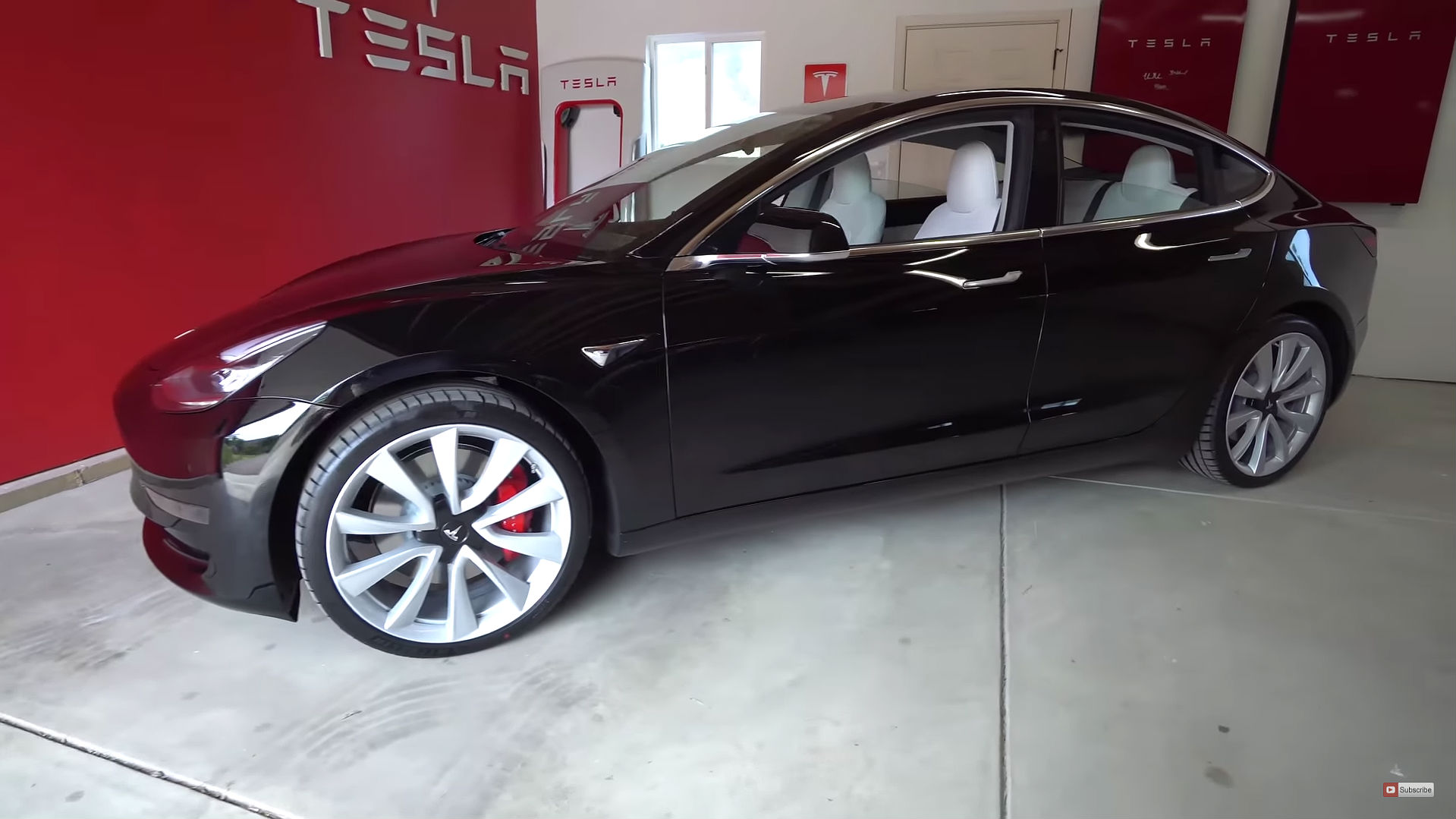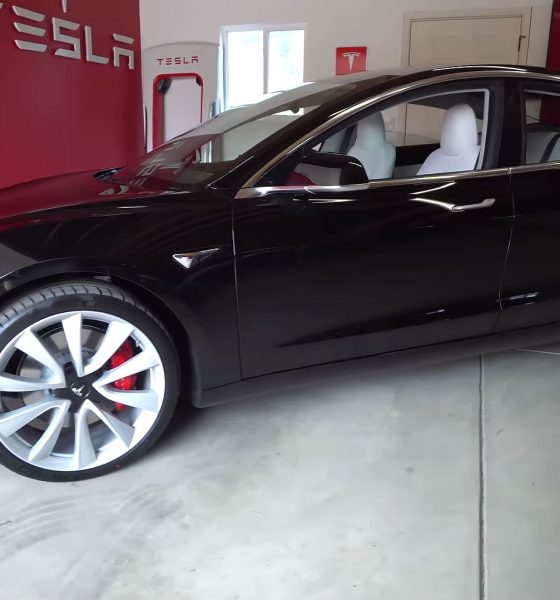

News
Tesla Model 3 Mid Range: $45k, 260-mile battery and rear wheel drive
No stranger to creating surprises (in 280 characters or less), Tesla CEO Elon Musk took to Twitter Thursday afternoon to announce that the company’s mass-market Model 3 sedan has been given a lower cost, Mid Range battery option that’s capable of 260 miles of range per single charge.
With a starting price of $45,000, the Model 3 Mid Range variant with rear wheel drive takes the Silicon Valley electric carmaker one step closer to offering the highly-anticipated $35,000 base version, which the company expects to produce in the first half of 2019.
Tesla’s first Model 3 variant, the 310-mile-capable Long Range version in a single motor, rear wheel drive configuration, will still be available for ordering directly through company sales representatives for another week, although the option has been removed from the Model 3 Design Studio.

The lower price for the Mid Range Model 3 represents a $4,000 savings from the Long Range rear wheel drive version that starts at $49,000 before incentives. However, this cost savings also equates to 50 miles less of driving range and reduced performance. 0-60 mph performance for the Mid Range Model 3 comes in at a modest 5.6 seconds versus 5.1 seconds for the Long Range version. Top speed for midrange Model 3 is also reduced to 125 mph (~200 kph).
Tesla Model 3 Version Comparisons
| 0-60 mph (sec) | Top Speed (mph) | Range (mi) | |
| Model 3 Mid Range (RWD) | 5.6 | 125 | 260 |
| Model 3 Long Range (RWD) | 5.1 | 140 | 310 |
| Model 3 Long Range (AWD) | 4.5 | 145 | 310 |
| Model 3 Performance (AWD) | 3.3 | 155 | 310 |
Elon Musk’s announcement of the lower-priced Tesla Model 3 should come as welcome news for the hundreds of thousands who have waited, some for more than two years, for the company to finally offer a truly affordable electric car that bests its competition in the luxury sedan market. At $45,000, the midrange Model 3 shares a similar base price as a 2019 BMW 330i series, yet tops the Bavarian heritage vehicle in both performance and technological innovation.
Arguably of more importance is Tesla’s strategic move to push higher-margin vehicles but also provide a favorable option for price-conscious consumers by creating a larger delineation between buyers looking to cost-cut and those seeking more range. By removing the RWD Long Range Model 3 as a vehicle selection, Tesla forces buyers that are looking for 310 miles of extended range to choose between a nearly $70,000 Model 3 Performance in basic trim or a $59,000 Model 3 Long Range with dual motor configuration. At a minimum, buyers looking for the long-range battery option will be spending $10,000 or more than they normally would have with the $49,000 RWD Long Range Model 3 as an available option.
According to the Tesla’s online configurator, buyers looking to purchase a Model 3 Mid Range can expect delivery in 6 to 10 weeks.
Model 3 long range, rear wheel drive is still available for ordering off menu for another week or so
— Elon Musk (@elonmusk) October 18, 2018

Elon Musk
Elon Musk and Tesla AI Director share insights after empty driver seat Robotaxi rides
The executives’ unoccupied tests hint at the rapid progress of Tesla’s unsupervised Robotaxi efforts.

Tesla CEO Elon Musk and AI Director Ashok Elluswamy celebrated Christmas Eve by sharing personal experiences with Robotaxi vehicles that had no safety monitor or occupant in the driver’s seat. Musk described the system’s “perfect driving” around Austin, while Elluswamy posted video from the back seat, calling it “an amazing experience.”
The executives’ unoccupied tests hint at the rapid progress of Tesla’s unsupervised Robotaxi efforts.
Elon and Ashok’s firsthand Robotaxi insights
Prior to Musk and the Tesla AI Director’s posts, sightings of unmanned Teslas navigating public roads were widely shared on social media. One such vehicle was spotted in Austin, Texas, which Elon Musk acknowleged by stating that “Testing is underway with no occupants in the car.”
Based on his Christmas Eve post, Musk seemed to have tested an unmanned Tesla himself. “A Tesla with no safety monitor in the car and me sitting in the passenger seat took me all around Austin on Sunday with perfect driving,” Musk wrote in his post.
Elluswamy responded with a 2-minute video showing himself in the rear of an unmanned Tesla. The video featured the vehicle’s empty front seats, as well as its smooth handling through real-world traffic. He captioned his video with the words, “It’s an amazing experience!”
Towards Unsupervised operations
During an xAI Hackathon earlier this month, Elon Musk mentioned that Tesla owed be removing Safety Monitors from its Robotaxis in Austin in just three weeks. “Unsupervised is pretty much solved at this point. So there will be Tesla Robotaxis operating in Austin with no one in them. Not even anyone in the passenger seat in about three weeks,” he said. Musk echoed similar estimates at the 2025 Annual Shareholder Meeting and the Q3 2025 earnings call.
Considering the insights that were posted Musk and Elluswamy, it does appear that Tesla is working hard towards operating its Robotaxis with no safety monitors. This is quite impressive considering that the service was launched just earlier this year.
Elon Musk
Starlink passes 9 million active customers just weeks after hitting 8 million
The milestone highlights the accelerating growth of Starlink, which has now been adding over 20,000 new users per day.

SpaceX’s Starlink satellite internet service has continued its rapid global expansion, surpassing 9 million active customers just weeks after crossing the 8 million mark.
The milestone highlights the accelerating growth of Starlink, which has now been adding over 20,000 new users per day.
9 million customers
In a post on X, SpaceX stated that Starlink now serves over 9 million active users across 155 countries, territories, and markets. The company reached 8 million customers in early November, meaning it added roughly 1 million subscribers in under seven weeks, or about 21,275 new users on average per day.
“Starlink is connecting more than 9M active customers with high-speed internet across 155 countries, territories, and many other markets,” Starlink wrote in a post on its official X account. SpaceX President Gwynne Shotwell also celebrated the milestone on X. “A huge thank you to all of our customers and congrats to the Starlink team for such an incredible product,” she wrote.
That growth rate reflects both rising demand for broadband in underserved regions and Starlink’s expanding satellite constellation, which now includes more than 9,000 low-Earth-orbit satellites designed to deliver high-speed, low-latency internet worldwide.
Starlink’s momentum
Starlink’s momentum has been building up. SpaceX reported 4.6 million Starlink customers in December 2024, followed by 7 million by August 2025, and 8 million customers in November. Independent data also suggests Starlink usage is rising sharply, with Cloudflare reporting that global web traffic from Starlink users more than doubled in 2025, as noted in an Insider report.
Starlink’s momentum is increasingly tied to SpaceX’s broader financial outlook. Elon Musk has said the satellite network is “by far” the company’s largest revenue driver, and reports suggest SpaceX may be positioning itself for an initial public offering as soon as next year, with valuations estimated as high as $1.5 trillion. Musk has also suggested in the past that Starlink could have its own IPO in the future.
News
NVIDIA Director of Robotics: Tesla FSD v14 is the first AI to pass the “Physical Turing Test”
After testing FSD v14, Fan stated that his experience with FSD felt magical at first, but it soon started to feel like a routine.

NVIDIA Director of Robotics Jim Fan has praised Tesla’s Full Self-Driving (Supervised) v14 as the first AI to pass what he described as a “Physical Turing Test.”
After testing FSD v14, Fan stated that his experience with FSD felt magical at first, but it soon started to feel like a routine. And just like smartphones today, removing it now would “actively hurt.”
Jim Fan’s hands-on FSD v14 impressions
Fan, a leading researcher in embodied AI who is currently solving Physical AI at NVIDIA and spearheading the company’s Project GR00T initiative, noted that he actually was late to the Tesla game. He was, however, one of the first to try out FSD v14.
“I was very late to own a Tesla but among the earliest to try out FSD v14. It’s perhaps the first time I experience an AI that passes the Physical Turing Test: after a long day at work, you press a button, lay back, and couldn’t tell if a neural net or a human drove you home,” Fan wrote in a post on X.
Fan added: “Despite knowing exactly how robot learning works, I still find it magical watching the steering wheel turn by itself. First it feels surreal, next it becomes routine. Then, like the smartphone, taking it away actively hurts. This is how humanity gets rewired and glued to god-like technologies.”
The Physical Turing Test
The original Turing Test was conceived by Alan Turing in 1950, and it was aimed at determining if a machine could exhibit behavior that is equivalent to or indistinguishable from a human. By focusing on text-based conversations, the original Turing Test set a high bar for natural language processing and machine learning.
This test has been passed by today’s large language models. However, the capability to converse in a humanlike manner is a completely different challenge from performing real-world problem-solving or physical interactions. Thus, Fan introduced the Physical Turing Test, which challenges AI systems to demonstrate intelligence through physical actions.
Based on Fan’s comments, Tesla has demonstrated these intelligent physical actions with FSD v14. Elon Musk agreed with the NVIDIA executive, stating in a post on X that with FSD v14, “you can sense the sentience maturing.” Musk also praised Tesla AI, calling it the best “real-world AI” today.








